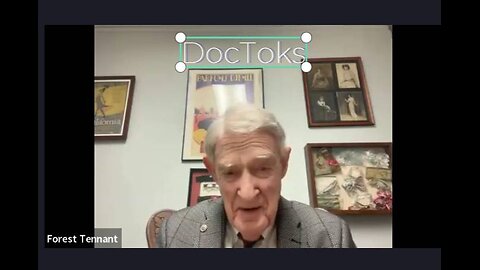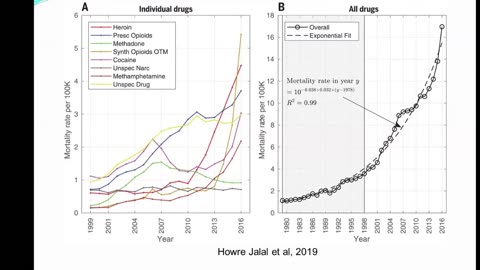
DocToks Season 6
11 videos
Updated 3 days ago
Doctoks Season 6
-
S6E10: Warning Signs Prior to Adhesive Arachnoiditis | Will Purdue's $7.4B Cause HARM?
 DocToks with Dr. Forest Tennant & FriendsDr. Tennant introduced the concept of a "precursor period" or "prologue period" in adhesive arachnoiditis development, where symptoms appear before formal diagnosis is possible. The Purdue Pharma opioid settlement was finalized for $7.4 billion, with Dr. Guess noting this sets a concerning legal precedent. Dr. Tennant emphasized that adhesive arachnoiditis is a chronic inflammatory disease requiring ongoing treatment beyond pain management. Epstein-Barr virus was discussed as a propagator (not originator) of inflammation in adhesive arachnoiditis. Ivermectin treatment for Epstein-Barr reactivation was reported as effective by Allison, showing improvements in both cognitive and physical symptoms. Recent anti-opioid claims about tramadol ineffectiveness and opioids causing cancer were refuted by Dr. Tennant and Dr. Guess.41 views
DocToks with Dr. Forest Tennant & FriendsDr. Tennant introduced the concept of a "precursor period" or "prologue period" in adhesive arachnoiditis development, where symptoms appear before formal diagnosis is possible. The Purdue Pharma opioid settlement was finalized for $7.4 billion, with Dr. Guess noting this sets a concerning legal precedent. Dr. Tennant emphasized that adhesive arachnoiditis is a chronic inflammatory disease requiring ongoing treatment beyond pain management. Epstein-Barr virus was discussed as a propagator (not originator) of inflammation in adhesive arachnoiditis. Ivermectin treatment for Epstein-Barr reactivation was reported as effective by Allison, showing improvements in both cognitive and physical symptoms. Recent anti-opioid claims about tramadol ineffectiveness and opioids causing cancer were refuted by Dr. Tennant and Dr. Guess.41 views -
S6E9: Controlling the Reactivated Virus | Hormones & Pain | Melissa W.'s Journey with CRPS and a SCI
 DocToks with Dr. Forest Tennant & FriendsDr. Tennant discussed the link between Epstein-Barr virus reactivation and adhesive arachnoiditis, emphasizing the importance of testing and treatment Melissa Wardlaw shared her journey with CRPS and spinal cord injury, highlighting how hormone replacement therapy significantly improved her condition The panel discussed the fraudulent use of terms like "central sensitization" and "hyperalgesia" to deny pain treatment Hormones (progesterone, estrogen, testosterone) play a crucial role in healing spinal cord injuries and managing pain A multimodal approach to pain management is most effective, including addressing general health, mental health, and using appropriate medications40 views 1 comment
DocToks with Dr. Forest Tennant & FriendsDr. Tennant discussed the link between Epstein-Barr virus reactivation and adhesive arachnoiditis, emphasizing the importance of testing and treatment Melissa Wardlaw shared her journey with CRPS and spinal cord injury, highlighting how hormone replacement therapy significantly improved her condition The panel discussed the fraudulent use of terms like "central sensitization" and "hyperalgesia" to deny pain treatment Hormones (progesterone, estrogen, testosterone) play a crucial role in healing spinal cord injuries and managing pain A multimodal approach to pain management is most effective, including addressing general health, mental health, and using appropriate medications40 views 1 comment -
S6E8: Pain Care Chronicles | Advocacy | Legal Challenges | Innovated Treatments
 DocToks with Dr. Forest Tennant & FriendsDr. Tennant discussed the importance of hormones in pain management, highlighting their role in tissue regeneration, immune function, and pain relief Pat Irwin provided updates on advocacy efforts in Washington state regarding medical board rules and opioid prescribing Monty shared news about an upcoming forum on December 17th at California State University, Sacramento, addressing patient care and prescription challenges Dr. Ibsen gave updates on his ongoing legal cases with medical boards The group discussed Dr. Anand's recent incarceration and plans to support him50 views 1 comment
DocToks with Dr. Forest Tennant & FriendsDr. Tennant discussed the importance of hormones in pain management, highlighting their role in tissue regeneration, immune function, and pain relief Pat Irwin provided updates on advocacy efforts in Washington state regarding medical board rules and opioid prescribing Monty shared news about an upcoming forum on December 17th at California State University, Sacramento, addressing patient care and prescription challenges Dr. Ibsen gave updates on his ongoing legal cases with medical boards The group discussed Dr. Anand's recent incarceration and plans to support him50 views 1 comment -
S6E7: Does Relief have a New Contender? | Julie's Substack: "My Probably Not-So-Rare Disease"
 DocToks with Dr. Forest Tennant & FriendsS6E7: Does Relief have a New Contender? | Julie's Substack: "My Probably Not-So-Rare Disease" Dr. Tennant introduced Journavx (suzetrigine), a new non-opioid pain medication approved for acute pain that shows promise for adhesive arachnoiditis, CRPS, and EDS patients Julie Titone presented her article "My Probably Not-So-Rare Disease" challenging the classification of adhesive arachnoiditis as rare. Arachnoiditis Hope has developed five treatment protocols now available on their website: Arachnoiditishope.com. Topics include general treatment, spinal fluid leakage, pain flares, emergency treatment after procedures, and Epstein-Barr virus reactivation Dr. Guess discusses supply chain issues for pain medications remain critical, with no improvement over the past 3-4 years despite DEA attempts to address shortages. Tune in for more!74 views
DocToks with Dr. Forest Tennant & FriendsS6E7: Does Relief have a New Contender? | Julie's Substack: "My Probably Not-So-Rare Disease" Dr. Tennant introduced Journavx (suzetrigine), a new non-opioid pain medication approved for acute pain that shows promise for adhesive arachnoiditis, CRPS, and EDS patients Julie Titone presented her article "My Probably Not-So-Rare Disease" challenging the classification of adhesive arachnoiditis as rare. Arachnoiditis Hope has developed five treatment protocols now available on their website: Arachnoiditishope.com. Topics include general treatment, spinal fluid leakage, pain flares, emergency treatment after procedures, and Epstein-Barr virus reactivation Dr. Guess discusses supply chain issues for pain medications remain critical, with no improvement over the past 3-4 years despite DEA attempts to address shortages. Tune in for more!74 views -
S6E6: Arachnoiditis Inflammation | Meaningful Connections | Modern-Day Miracles!
 DocToks with Dr. Forest Tennant & FriendsInflammation is the root cause of adhesive arachnoiditis and must be treated alongside pain symptoms with a multi-drug approach. Two cornerstone medications for treating spinal canal inflammation are methylprednisolone (Medrol) or dexamethasone, and ketorolac (Toradol), recommended 1-3 days per week at low doses. Glutathione, a tripeptide antioxidant, shows promise as an anti-inflammatory supplement with minimal side effects. Pain clinics typically treat symptoms rather than underlying diseases, requiring patients to take responsibility for their disease management. Dr. Ibsen faces federal investigation after treating 80 pain refugees, highlighting the ongoing persecution of physicians who treat chronic pain patients. An anti-inflammatory diet rich in fruits and vegetables, while avoiding sugar surges, supports inflammation control. Epstein-Barr virus testing and treatment are recommended for all patients with adhesive arachnoiditis.71 views
DocToks with Dr. Forest Tennant & FriendsInflammation is the root cause of adhesive arachnoiditis and must be treated alongside pain symptoms with a multi-drug approach. Two cornerstone medications for treating spinal canal inflammation are methylprednisolone (Medrol) or dexamethasone, and ketorolac (Toradol), recommended 1-3 days per week at low doses. Glutathione, a tripeptide antioxidant, shows promise as an anti-inflammatory supplement with minimal side effects. Pain clinics typically treat symptoms rather than underlying diseases, requiring patients to take responsibility for their disease management. Dr. Ibsen faces federal investigation after treating 80 pain refugees, highlighting the ongoing persecution of physicians who treat chronic pain patients. An anti-inflammatory diet rich in fruits and vegetables, while avoiding sugar surges, supports inflammation control. Epstein-Barr virus testing and treatment are recommended for all patients with adhesive arachnoiditis.71 views -
S6E5: Z51.5: Legacy Patients: The 8 Major Symptoms of AA: Exciting News From DocToks!
 DocToks with Dr. Forest Tennant & FriendsDouble-Denial: Z51.5: Legacy Patients: Palliative Care Charting Criteria: EXEMPT from CDC Guidelines: Do You Have Any of the 8 Major Symptoms of AA? Exciting News From DocToks! Dr. Tennant emphasized that symptoms should be given more weight in diagnosis than MRI results. He detailed the 8 major symptoms that patients with adhesive arachnoiditis typically experience (with at least 4 present in confirmed cases): Dr. Tennant identified 8 major symptoms of adhesive arachnoiditis, emphasizing that symptoms should be given more weight in diagnosis than MRI results PEA (palmitoylethanolomide) at high doses (600mg twice daily for 1 month, then 1200mg twice daily for 2-3 months) may help reverse central pain Dr. Tennant has updated the starting protocol for adhesive arachnoiditis to PEA and ivermectin instead of Katorolac and methylprednisolone Palliative care designation (ICD-10 code Z51.5) provides protection for doctors and benefits for patients with incurable conditions Vitamin supplementation (C, B12, D, and minerals like magnesium) is important for pain management and preventing Epstein-Barr virus reactivation134 views
DocToks with Dr. Forest Tennant & FriendsDouble-Denial: Z51.5: Legacy Patients: Palliative Care Charting Criteria: EXEMPT from CDC Guidelines: Do You Have Any of the 8 Major Symptoms of AA? Exciting News From DocToks! Dr. Tennant emphasized that symptoms should be given more weight in diagnosis than MRI results. He detailed the 8 major symptoms that patients with adhesive arachnoiditis typically experience (with at least 4 present in confirmed cases): Dr. Tennant identified 8 major symptoms of adhesive arachnoiditis, emphasizing that symptoms should be given more weight in diagnosis than MRI results PEA (palmitoylethanolomide) at high doses (600mg twice daily for 1 month, then 1200mg twice daily for 2-3 months) may help reverse central pain Dr. Tennant has updated the starting protocol for adhesive arachnoiditis to PEA and ivermectin instead of Katorolac and methylprednisolone Palliative care designation (ICD-10 code Z51.5) provides protection for doctors and benefits for patients with incurable conditions Vitamin supplementation (C, B12, D, and minerals like magnesium) is important for pain management and preventing Epstein-Barr virus reactivation134 views -
S6E4: Adhesive Arachnoiditis: Incurable & BREAKABLE! | Pat I. & Dr Haddadan Special Advocacy Support
 DocToks with Dr. Forest Tennant & FriendsDr. Tennant introduced a new protocol for adhesive arachnoiditis that doesn't use corticosteroids or ketorolac, instead using pregnenolone and DHEA as alternatives The Tennant Protocol has three components: suppress inflammation/autoimmunity, regenerate damaged tissue, and control pain Dr. Kivan Haddadin shared his experience with the California Medical Board's investigation, highlighting issues with the medical board process Medical boards often target doctors who take on complex cases, with disproportionate punishments for minor infractions The State Board Initiative aims to support physicians facing medical board investigations and advocate for reform63 views
DocToks with Dr. Forest Tennant & FriendsDr. Tennant introduced a new protocol for adhesive arachnoiditis that doesn't use corticosteroids or ketorolac, instead using pregnenolone and DHEA as alternatives The Tennant Protocol has three components: suppress inflammation/autoimmunity, regenerate damaged tissue, and control pain Dr. Kivan Haddadin shared his experience with the California Medical Board's investigation, highlighting issues with the medical board process Medical boards often target doctors who take on complex cases, with disproportionate punishments for minor infractions The State Board Initiative aims to support physicians facing medical board investigations and advocate for reform63 views -
S6E3: Why Does my Pain Keep Getting Worse?
 DocToks with Dr. Forest Tennant & FriendsCentral pain is defined as an injury inside the central nervous system (brain and spinal cord) that causes constant pain The hallmark symptoms of central pain are constant pain that never goes away and cold hands/feet Central pain is often caused by neuroinflammation in glial cells, which normally regulate and shut down pain Central pain typically occurs alongside other painful conditions like fibromyalgia, arachnoiditis, CRPS, or arthritis Treatment requires a multi-faceted approach, including neuropathic agents, opioids, anti-inflammatory medications, and lifestyle modifications Neuroinflammation must be aggressively treated to prevent progression and worsening of symptoms Autoimmunity (from diseases or post-viral conditions) appears to be a major cause of central pain. Central pain refers to an injury within the central nervous system, which includes the brain and spinal cord, that results in persistent pain. The primary symptoms of central pain include constant, unrelenting pain and cold hands or feet. This type of pain is often linked to neuroinflammation occurring in glial cells, which normally help regulate and terminate pain signals. Central pain frequently coexists with other painful conditions, such as fibromyalgia, arachnoiditis, complex regional pain syndrome (CRPS), or arthritis. Effective treatment requires a multi-faceted approach that includes neuropathic agents, opioids, anti-inflammatory medications, and lifestyle modifications. It is crucial to aggressively address neuroinflammation to prevent the progression and worsening of symptoms. Additionally, autoimmunity, whether from diseases or post-viral conditions, appears to be a significant contributor to central pain.82 views 5 comments
DocToks with Dr. Forest Tennant & FriendsCentral pain is defined as an injury inside the central nervous system (brain and spinal cord) that causes constant pain The hallmark symptoms of central pain are constant pain that never goes away and cold hands/feet Central pain is often caused by neuroinflammation in glial cells, which normally regulate and shut down pain Central pain typically occurs alongside other painful conditions like fibromyalgia, arachnoiditis, CRPS, or arthritis Treatment requires a multi-faceted approach, including neuropathic agents, opioids, anti-inflammatory medications, and lifestyle modifications Neuroinflammation must be aggressively treated to prevent progression and worsening of symptoms Autoimmunity (from diseases or post-viral conditions) appears to be a major cause of central pain. Central pain refers to an injury within the central nervous system, which includes the brain and spinal cord, that results in persistent pain. The primary symptoms of central pain include constant, unrelenting pain and cold hands or feet. This type of pain is often linked to neuroinflammation occurring in glial cells, which normally help regulate and terminate pain signals. Central pain frequently coexists with other painful conditions, such as fibromyalgia, arachnoiditis, complex regional pain syndrome (CRPS), or arthritis. Effective treatment requires a multi-faceted approach that includes neuropathic agents, opioids, anti-inflammatory medications, and lifestyle modifications. It is crucial to aggressively address neuroinflammation to prevent the progression and worsening of symptoms. Additionally, autoimmunity, whether from diseases or post-viral conditions, appears to be a significant contributor to central pain.82 views 5 comments -
S6E2 Navigating Epstein-Barr Virus | Reducing Pro-Inflammatory Cytokines | Ivermectin
 DocToks with Dr. Forest Tennant & FriendsThis episode of DocToks with Dr. Forrest Tennant and Friends (Season 6, Episode 2) focused on the Epstein-Barr virus (EBV) and its role in chronic pain conditions, particularly adhesive arachnoiditis. Dr. Tennant reviewed his published work on EBV as a causative factor in chronic pain and discussed emerging treatments, with special emphasis on ivermectin. The show featured guest speakers Allison Guyton, who shared her personal experience using ivermectin to treat EBV-related symptoms, and Dr. Scott Guest, who provided pharmacological information about ivermectin. Key Concepts or Theories: Epstein-Barr virus as a causative factor in chronic pain conditions through tissue colonization EBV's ability to create autoimmunity that can destroy tissue and cause painful conditions The potential role of EBV in causing central pain by affecting glial cells in the brain Ivermectin as an emerging treatment for EBV-related chronic pain conditions98 views 1 comment
DocToks with Dr. Forest Tennant & FriendsThis episode of DocToks with Dr. Forrest Tennant and Friends (Season 6, Episode 2) focused on the Epstein-Barr virus (EBV) and its role in chronic pain conditions, particularly adhesive arachnoiditis. Dr. Tennant reviewed his published work on EBV as a causative factor in chronic pain and discussed emerging treatments, with special emphasis on ivermectin. The show featured guest speakers Allison Guyton, who shared her personal experience using ivermectin to treat EBV-related symptoms, and Dr. Scott Guest, who provided pharmacological information about ivermectin. Key Concepts or Theories: Epstein-Barr virus as a causative factor in chronic pain conditions through tissue colonization EBV's ability to create autoimmunity that can destroy tissue and cause painful conditions The potential role of EBV in causing central pain by affecting glial cells in the brain Ivermectin as an emerging treatment for EBV-related chronic pain conditions98 views 1 comment








